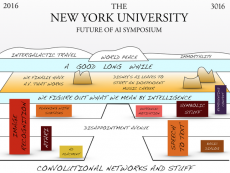Sidebar
Part I
The limits of empiricism.
- …
Part II
The gap
- …
Part III
Causes and effects
- …
Part IV
Causal intuitions
- …
This is an old revision of the document!
Table of Contents
From Machine Learning to Artificial Intelligence
There is a big gap between our Machine Learning techniques and our ambition to make a dent in Artificial Intelligence. The purpose of these pages is to explain the nature of the gap, that is, clarify some of the problem we must solve, and describe conceptual tools to reason about them and maybe lead to solutions.
I am planning to add new pages every so often. The most recent additions are listed below in blog style. Since I expect that all these pages will form a coherent ensemble, the sidebar list them as a table of contents, in the order they are expected to be read in the end.
Confounding
This post presents and comments a classic example of confounding variable in real life. The intricacies of the phenomenon and their relation to Bayes'rule are discussed in a second post).
Probabilistic vs. Causal inference
This post revisits the confounding phenomenon under the angle of probabilistic reasoning with conditional probabilities and Bayes' theorem. This analysis reveals what sets probabilistic and causal inference apart. It also shows how probabiistic models and causal models formulate assumptions of a fundamentally different nature.
Tip: Feel free to jump to the conclusion if you find this discussion too technical.
Causation without decisions
The foundational texts on statistical causation[1][2] frequently remind us that causal inference is necessary to estimate the outcomes of decisions. Suppose for instance that we have access to a trove of medical reports describing the outcomes $Z$ of applying medical treatment $Y$ to patients presenting symptom $X$. It is well known that the conditional distribution $P(Z|X,Y)$ estimated using such a dataset is a poor way to determine which treatment works best. More precisely, this approach fails badly when there exist so called confounding variables $U$ that
- were not included in the report, but
- have affected the treatment choices made by the doctors, and
- have an impact on the outcomes.
AI for the open world
We propose that a 2 month, 10 man study of artificial intelligence be carried out during the summer of 1956 at Dartmouth College in Hanover, New Hampshire. The study is to proceed on the basis of the conjecture that every aspect of learning or any other feature of intelligence can in principle be so precisely described that a machine can be made to simulate it. An attempt will be made to find how to make machines use language, form abstractions and concepts, solve kinds of problems now reserved for humans, and improve themselves. We think that a significant advance can be made in one or more of these problems if a carefully selected group of scientists work on it together for a summer. McCarthy, Minsky, Rochester, and Shannon, 1955 [3]
It is well known that things did not go that easily.
